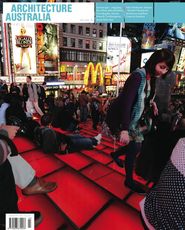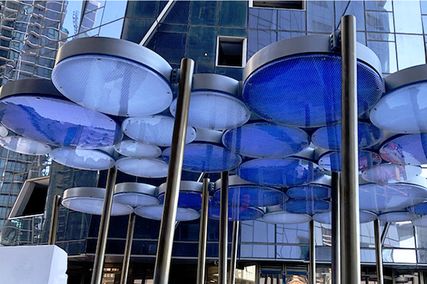How can the built environment effectively contribute to lowering Australia’s carbon emissions? Natasha Palich of Sense Architecture reviews ASBEC’s report The Second Plank – Building a Low Carbon Economy with Energy Efficient Buildings.
The Second Plank – Building a Low Carbon Economy with Energy Efficient Buildings is one of the more recent reports published over the past two years on buildings and their role in greenhouse gas abatement within the context of a carbon trading scheme. The title refers to Prime Minister Rudd’s description in August 2008 of energy efficiency as the “second plank” of Australia’s greenhouse gas abatement action, the first policy plank being the Carbon Pollution Reduction Scheme (CPRS).
The report was published by the Australian Sustainable Built Environment Council (ASBEC) – a peak body of industry and professional organizations working towards a more sustainable built environment – and was a response to the recently released federal government white paper, Carbon Pollution Reduction Scheme: Australia’s Low Pollution Future, which outlines the proposed CPRS for Australia.
In the CPRS white paper, the federal government identified a “medium term national emissions reduction target of between 5 per cent and 15 per cent of 2000 levels by 2020”. A national emissions cap is yet to be publicly nominated but will be announced prior to the commencement of the CPRS in July 2010. The CPRS will initially capture about 75 percent of Australia’s emissions and will set “mandatory obligations for around 1000 entities”, these being the nation’s largest polluters, such as power stations and heavy manufacturing. A national annual emissions cap will be established by the government, which will aim to limit the amount of greenhouse gas emissions produced by Australia. The proposed caps are expected to be announced in March 2010.
Under the CPRS, only these top 1000 entities have to buy permits. The rest of the economy is placed as “downstream” consumers of energy. The intention is that large polluters will have increased costs associated with limited carbon permits, which they will pass on to their customers, who will be encouraged (by the higher cost of energy) to invest in energy efficiency.
What this means for building owners, however, is that when the CPRS is introduced, energy efficiency strategies implemented in a building will not actually reduce Australia’s greenhouse gas emissions, but rather will make it easier and cheaper for the major greenhouse gas emitters to meet their emissions obligations. Actual ongoing reductions in Australia’s greenhouse gas emissions will be determined by adjusting the national cap on emissions.
A principal argument of the ASBEC report is that without additional policy measures (described as “complementary” to the CPRS), the full potential for greenhouse gas abatement within the building sector will not be realized. Constraints include, for example, the limited incentive building owners have to upgrade buildings when tenants pay the energy bills. The report argues that this is a crucial consideration, as the building sector may offer the greatest and least expensive opportunities for emissions reductions: 30–35 percent reduction against business as usual by 2050, with the initial costs offset by the energy savings over time.
The Second Plank report argues that to reduce energy demand as much as possible in the building sector, financial incentives are required. The report identifies a range of greenhouse gas abatement policy initiatives aimed at overcoming the inherent barriers to energy efficiency in buildings. These initiatives broadly fit within five categories:
- private sector incentives
- publicly funded incentives
- regulated performance
- research generation
- knowledge dissemination
This process identified a series of keystone policies and support policies. Of twenty-one policy initiatives put forward in the report, seven were identified as keystone policies. Of these seven, ASBEC has focused on three, which it believes are “necessary to motivate the long term structural change and significant level of investment required to achieve greater energy efficiency in the building sector”. These are a national white certificate scheme, green depreciation and public funding for retrofitting buildings.
A white certificate scheme is essentially a process of quantifying and placing a value on energy saved through the application of energy efficiency measures. The energy saved is measured against an agreed standard. The ASBEC report argues that white certificates give energy a higher value in a business model encouraging energy efficiency. Most states are introducing or have already introduced energy efficiency trading schemes, some of which include the creation of “certificates” representing greenhouse gas emissions saved.
Green depreciation encourages investment in energy efficiency strategies by providing “accelerated depreciation for buildings that meet a specified environmental standard”. Green depreciation “would allow the deferment of tax by reducing the taxable income in early years in exchange for increased taxable income in future years. It provides an incentive to building owners to ‘green’ buildings by providing benefits (based on the time value of money) that arise from deferring tax payments.”1 However, as the ASBEC report acknowledges, green depreciation is unlikely to result in increased investment in building refurbishment.
Publicly funded retrofitting targets the gap between the initial outlays for energy efficiency measures and the payback. Funding the initial cost encourages building owners to invest in energy efficiency, as the payback period of the investment is reduced.
The ASBEC report also highlights regulatory policy initiatives in its keystone policies, including increasing the minimum energy efficiency requirements in the Building Code and increasing minimum energy performance standards for appliances. While the report suggests that “the building sector’s potential … could not be completely realised” without adopting all the keystone polices, it emphasizes the three financial incentive keystone policies outlined above, suggesting they are immediately necessary to “motivate the structural change required to achieve greater energy efficiency in the building sector”.
The federal government’s white paper is non-specific on future policy approaches to building energy efficiency. The paper commits to delivering “household energy efficiency initiatives building on existing programs”2 but then relies on the future development by COAG of the National Strategy for Energy Efficiency (NSEE). It is expected that the NSEE will be finalized by June 2009 and will identify the government’s proposed policy initiatives for energy efficiency. Initial steps include the introduction of national legislation for appliance energy performance standards – subject to a regulatory impact statement.3 The Climate Institute emphasizes that “[i]mportantly, the National Strategy for Energy Efficiency must be framed as a package of policy measures, rather than as a collection of stand-alone policies and programs”.4 It is within the context of the NSEE that the complementary measures proposed by the ASBEC report would be rolled out as part of the government’s policy actions on energy efficiency.
The general consensus is that there isn’t a silver-bullet policy to achieve energy efficiency. Rather, it will require a range of complementary measures, including regulatory change, information provision, financial incentives and behaviour change strategies. The Second Plank acknowledges the work the government has done on information provision, but argues that an immediate focus on financial incentives is required to reduce energy use in the building sector. More importantly, it suggests that the proposed Carbon Pollution Reduction Scheme has failed to capture the full carbon and cost savings potential of the built environment.
Natasha Palich is the principal of Sense Architecture. She practises as an architect and a sustainable design consultant.
1. Green depreciation – A preliminary analysis, Centre for International Economics, October 2007, p. 7.
2. Carbon Pollution Reduction Scheme: Australia’s low pollution future white paper, 15 December 2008, chapter 19, p. 6.
3. http://www.coag.gov.au/coag_meeting_outcomes/2008-10-02/index.cfm
4. Australia’s National Strategy for Energy Efficiency Policy Paper, The Climate Institute, November 2008, p.7.
FURTHER INFORMATION
Sense Architecture
Sense Architecture is an architectural practice that also offers sustainable design advice and industry advocacy.
W www.sensearchitecture.com.au
Australian Sustainable Built Environment Council
ASBEC is the peak body of organizations committed to a sustainable built environment in Australia. Its objective is “for Australia to be a leader in reducing ecological impacts, improving economic returns and extending community amenity of the built environment”. The Second Plank summary and full report can be downloaded from the website.
E info@asbec.asn.au
W www.asbec.asn.au
Department of Climate Change, Australian Government
The department’s website includes information on the white paper Carbon Pollution Reduction Scheme: Australia’s Low Pollution Future.
W www.climatechange.gov.au/whitepaper/index.html
The Climate Institute
An independent research organization that works with community, business and government to drive innovative and effective climate change solutions.
W www.climateinstitute.org.au
Climate Change In Australia
The report Climate Change in Australia is “based upon international climate change research including conclusions from the Intergovernmental Panel on Climate Change fourth assessment report. It also builds on a large body of climate research that has been undertaken for the Australian region in recent years.” The report can be downloaded from the website.
W www.climateinstitute.org.au















